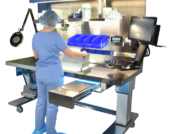
Effective Education: Various Teaching Methods to Incorporate in SPD
In August, we brought our Voice of the Customer panel together to delve into a topic that SPD professionals across country identified as top-of-mind in our 2023 SPD State of the Industry Report: Training & Education.
We collaborated with Beth Rayfield, Director of SPD at IU Health, to further explore what our Voice of the Customer panel had to say about training & education.
Digital learning – Opportunities and Pitfalls
One common practice among many VOC members is the utilization of digital learning methods, and with good reason. Digital learning, such as vendor resources, videos, and structured e-learning courses provide departments several benefits, including:
- Asynchronous learning: Gone are the days of needing to align the schedules of people across teams, shifts, and departments. Digital resources allow departments to deploy learning opportunities in an on-demand format, fitting into the nooks and crannies of employees’ availabilities.
- Cost-effectiveness: The reuse factor of digital resources means that departments save a considerable amount of money and time per use compared with having an educator facilitating the course.
- Onboarding: Digital resources do not vary from use to use; they provide a consistent experience each time they’re used. Coupled with their on-demand nature, digital training resources contribute to a streamlined, consistent onboarding experience for every teammate.
- Reception: Rayfield pointed out that younger team members are very receptive to, and often prefer, to use digital training tools.
Despite they’re wide-ranging benefits, though, digital resources do have their downsides as well:
- Approval: With so many digital resources available on the internet, there’s a lot to choose from. Determining what’s valuable, credible, and worthwhile can be a challenge. Departments that don’t have the bandwidth or resources to create their own digital learning tools often rely on online tools, but verification and approval can prove to be a time-consuming challenge.
- Creation: Departments that want to tailor their training and educational resources come across a separate challenge: creating the content themselves. The coordination and effort required to accomplish this can be off-putting to departments that might not have the technical knowledge or in-house familiarity with content creation tools. Outsourcing can also eat up precious budget with notable opportunity costs.
- Questions: Interactivity with digital tools can be severely limited. While exams and digital tools can be created to offer interactive elements, asynchronous learning generally doesn’t afford the learner the ability to ask questions and seek clarification from a subject matter expert.
Hands-on approaches
Some technicians find that having processes and activities explained to them doesn’t cut it in terms of obtaining a complete understanding of the information being taught. It’s one thing to be told how to separate scissors, it’s another thing entirely to do it yourself. Rayfield explained that there are two key approaches to helping leaners get hands-on experience:
- On-the-job: As an SPD Director, Rayfield has been in several different SPD leadership positions, and in each one of them she enabled staff to learn while working. When a technician explains that they are struggling with how to disassemble an instrument, or complete a certain step of an IFU, for instance, encourage them to spend time getting it down. It may mean a little less gets done that day, but it provides the opportunity for the technician to truly develop a more complete understanding of how to complete the task, setting them up for future success.
- See one, do one, teach one: To achieve and demonstrate a comprehensive understanding of something, Rayfield has her members of departments see one, do one, and teach one. This allows the information to be explained to the team, get hands-on and do it themselves, and ultimately teach it to others, demonstrating mastery of the topic.
Conclusion
There’s no shortage of training and educational resources available to sterile processing departments. Finding the right mix of methods for your team can be a bit more challenging. Mixing and matching some of these options and finding good resources to consistently turn to can help get your team the training and education they need to thrive at work.
Interested in free CE’s for you and your team? Check out these free options!
About: Voice of the Customer Committee
The Voice of the Customer Committee is a panel of healthcare and instrument reprocessing professionals who have graciously donated their time to share their expertise and guidance on current challenges faced by the instrument reprocessing community. Through sharing their insights, experiences, and best practices, we have been given the opportunity to share these findings with our readership. We’d like to thank our VOC members for their outstanding input and insights, as well as their time! Thank you for your continued partnership, and all you do.



